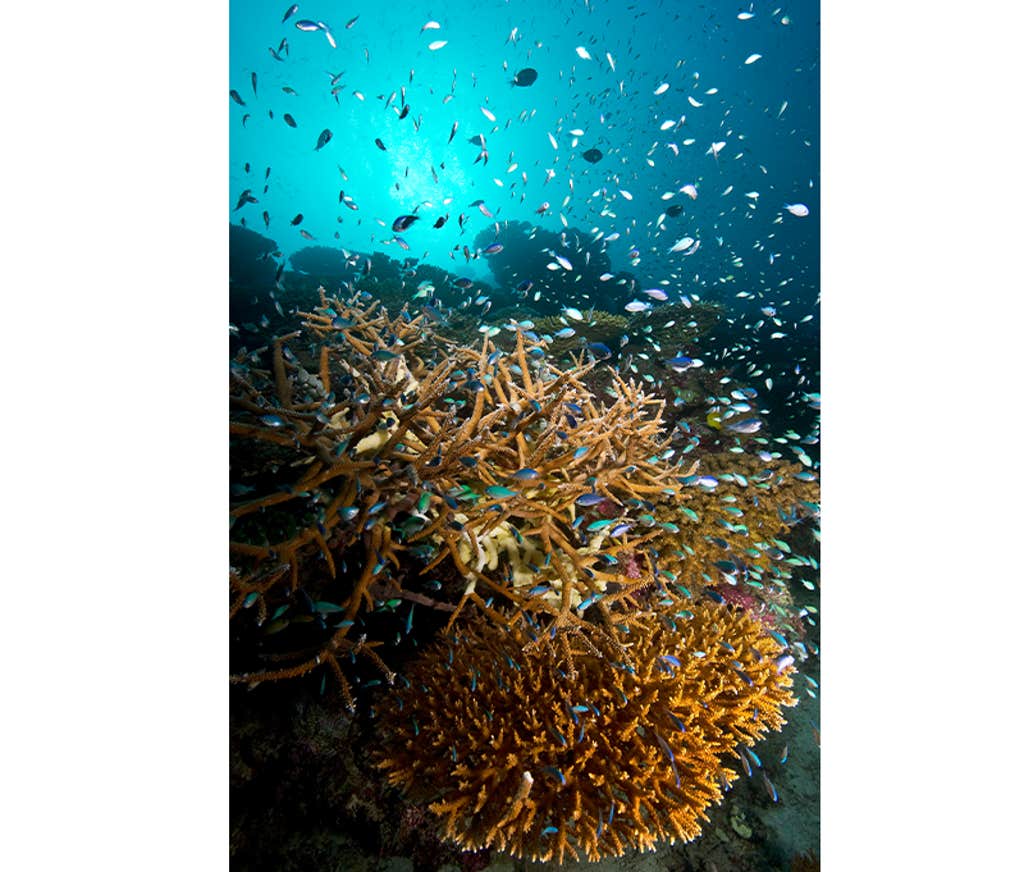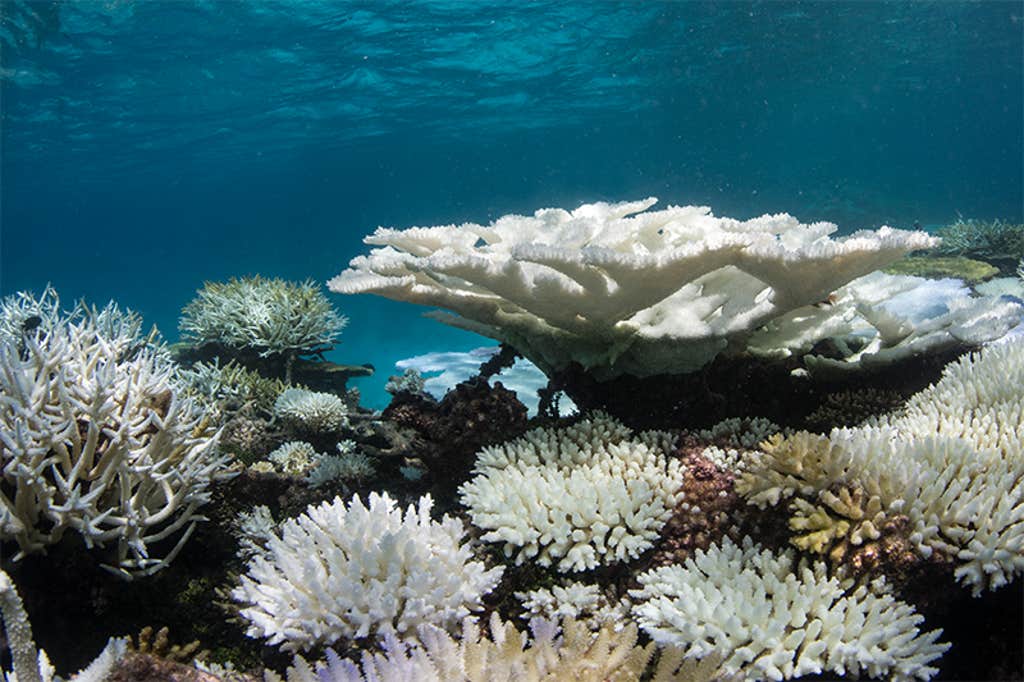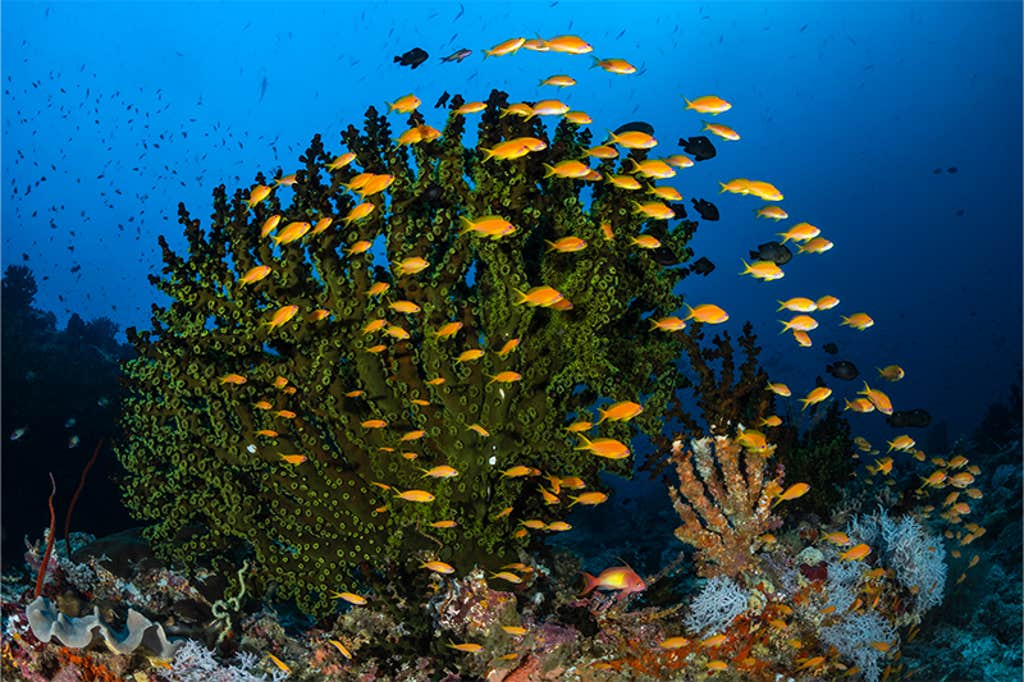It’s a steamy summer night a few hours after sunset anywhere in the tropics. A few days ago, the full moon rose above the ocean and, like the final piece of a puzzle clicking into place, it set in motion the most consequential event in the life of a coral: sending offspring into the future.
Like us, coral are animals. But stuck to the seafloor they can’t go out and find a mate. Instead, many species of coral spawn with unique timing known only to their kind, giving their eggs and sperm, collectively called gametes, the best shot at meeting each other, fertilizing, and growing into a tiny larva half the size of a rice grain. A few days to a few weeks later, if the larva is lucky, it will find a spot on the seafloor and begin to build, molecule-by-molecule, a calcium carbonate skeleton adding to the greatest biological structures on our planet.
Romantic as all this moonlit mingling is, it’s also been a major stumbling block for coral scientists. “Basic information about reproduction is critical to develop a conservation plan for any animal,” coral scientist and aquarist Jamie Craggs explains. With corals spawning just once a year and scuba divers limited in the number of corals they can watch a night, progress understanding coral reproduction has been unbearably slow for decades.
By 2050, 99 percent of all corals will be lost due to warming ocean waters.
Scientists are also racing to better understand what helps coral ecosystems thrive. Research in remote islands in the Indian Ocean has uncovered surprising connections between the nutrients in seabird guano and healthy reefs. Working in these finely-balanced systems, Lancaster University’s Nicholas Graham discovered that where invasive rodents have depressed seabird populations, coral suffer significantly. Such work provides key information to conservation plans for coral reefs, whose intricate architecture provides habitat to nearly 900,000 species, a quarter of all that live in the sea.
And today’s coral are in dire need of such conservation plans. The most recent United Nations Framework on Climate Change predicts that by 2050, 99 percent of all corals will be lost due to warming ocean waters. Like Craggs, working in aquariums, and Graham, studying reefs in the field, researchers are urgently looking for solutions. While the corals wait for climate change to be addressed, these scientists are finding them.
Craggs spent 24 years as an aquarist in public aquariums, the past 17 at London’s Horniman Museum & Gardens where he’s the principal curator of the Aquarium and Living Collection Manager. “Whenever you manage an aquarium,” he says, “you strive to breed your animals because it shows that your husbandry is at the level that everything’s healthy.” Soon after arriving at the Horniman, Craggs began collaborating with coral scientist Mike Sweet at the University of Derby, and helped set up aquaria to study coral microbiomes and disease. But, the technologies for coral spawning hadn’t been invented.
So, Craggs turned his attention to jellyfish, which are close kin to corals. Take a jellyfish, flip it upside down, imagine a skeleton around it, merge a bunch of those into a colony, and you’ve got a sense of a coral’s anatomy. Craggs learned to tell if a medusae held eggs or sperm and how to grow jellyfish larvae—and ultimately jellyfish. The breakthrough that allowed him to breed jellyfish came when he received 20 years of water temperature data that showed how the jellyfish use environmental clues to spawn. “I was like, ‘Why don’t we apply this exact methodology to corals?’ ” Craggs says, “They’re cousins, right?”

Craggs was sitting at his kitchen table reading a Twitter feed from Fiji when the idea coalesced into a plan. A dive shop there pinpointed the coral spawning so well that they were selling trips to see it. “That tweet got me down this rabbit hole,” he says, working out “the seasonal temperature, the photoperiod, the lunar cycles, all of the things that stack up to trigger the coral to spawn.”
On a shoestring budget, Craggs built blackout blinds around the aquaria that he’d been using for the coral microbiome and disease work. A volunteer who knew something about IT reprogrammed a microprocessor to mimic Fiji’s annual cycles of temperature, moonlight, and sunlight. They placed coral in the system—and waited. Nine months later, in alignment with Fiji’s reefs, the corals in London released their gametes. “And that literally changed everything,” Craggs says.
Craggs’ next innovation came, like so many in science, from a mistake. Hoping to expand the project, he teamed up with scientist James Guest working in Singapore to ship 14 coral colonies to the Horniman. He reprogrammed the lighting and temperatures in his system to match those in the corals’ native sea. Spawning was supposed to happen around 9:30 p.m., which made for a late night, given that Craggs’ workday at the aquarium started at 8 a.m. From Singapore, Guest reported that the corals had released gametes. But nothing was happening in London.
Craggs kept watching, late night after late night. Finally, exhausted, Craggs decided to halt the observations. Maybe the travel had shifted the corals’ cues. Maybe they would spawn following the next full moon.
But the next month, when Craggs checked the corals for eggs, they were empty. The corals had spawned. “We’d missed the whole lot,” he says. No one had been watching. “It was the biggest learning curve of the whole process,” he says. “It got me thinking, ‘We’re still thinking like we’re in the field.’ Let’s make sunset happen at half past 10 in the morning. And make the coral spawn in our working day.”
Progress understanding coral reproduction has been unbearably slow for decades.
This insight led to a “phase-shifted spawn,” where a system is programmed to induce spawning whenever scientists most need larvae for their research. For example, coral restoration scientists can produce larvae year round, grow them into colonies, and put large numbers back on the reef. Or coral scientists can test many larvae to see which can withstand warmer temperatures before putting them in a breeding program. Or they can produce gametes from coral from different locations at the same time and fertilize them to form larvae that might not otherwise occur in nature. These hybrids might be able to withstand warmer seas. “By manipulation, ex-situ spawning [or spawning outside the reef] creates huge opportunity.”
After Craggs had cracked the code for ex-situ spawning, requests for information arrived from around the world. Craggs wrote up blueprints in what turned into a doctoral dissertation and started a company called the Coral Spawning Lab to provide coral reproduction equipment and services. One product is a large rectangular unit designed to be wheeled through a doorway into a lab. All that’s needed is to mount the lights, plug it in, and add seawater. “Off you go, basically,” Craggs says. “We tried to make it as plug-and-play as possible.” To date, 50 coral species have been spawned in these units in about a dozen countries.
As Craggs’ innovations have accrued, so have his questions about how to best support coral conservation. “How do we scale up?” he asks. That has meant taking the step from coral reproduction to rearing larvae into coral colonies.

In the Maldives in the Indian Ocean, Craggs has designed a new kind of aquarium system. This “V-shaped raceway takes its inspiration from a meandering river,” Craggs says, “but also thinking about a model railway as a kid.” He explains that animal waste has to be carefully removed from aquaria or it will kill the coral. Building the bottom of the aquarium into a “V” means gravity does most of the work. “We can just run a siphon hose along the middle and remove the detritus,” he explains. Like building a model train track, the system is composed of five different parts that can be bolted together in any number of configurations, and the riverine design minimizes the size of pumps needed and therefore energy use. Each raceway can hold upward of 10,000 corals, so linking together four or five raceways quickly multiplies the colonies a system can support.
And Craggs is already thinking about the next challenge: cost. While the systems he’s engineered have opened new realms in coral research, they are also pricey. He imagines developing coral reproduction and growth systems out of low-cost materials like concrete or mud and bamboo and using local labor and building skills. Craggs says. “I think these worlds, working together, can achieve amazing things. The combination of science and husbandry. That’s the secret to success.”
Collaborations are also key to Lancaster University’s Nick Graham, whose groundbreaking work on coral reefs has focused on what can be learned in the field. “I’ve always been interested in trying to understand how different parts of the ecosystem are joined up,” he says.
After earning his doctoral degree working in the Great Barrier Reef, Graham served as an ichthyologist on several multi-institutional multi-disciplinary research trips to the Chagos Archipelago. As part of a large marine sanctuary in the middle of the Indian Ocean, the region has been protected from fishing and mostly uninhabited by people since the 1970s. That makes it home to some of the world’s most pristine marine habitats and hailed as a key location for coral research.
Ornithologists Graham met on those trips pointed out that some islands had dense seabird populations, and others almost none. The reason was that hundreds of years ago, explorers inadvertently infested some of the islands with rats. Those rats preyed on birds’ eggs and chicks. Around the same time, native trees were razed for coconut palms, further decreasing habitat for seabirds. Consequently, the abundance of seabirds was 760 times higher on rat-free islands than on “ratty” islands. Graham wondered if the presence of seabirds affected other elements of the ecosystem, such as fish and corals. “And the penny sort of dropped that, well, those seabirds could be having a big influence on the reefs,” he says.
Graham had a hypothesis as to why. Because of the way global ocean currents flow, tropics are nutritional deserts with very little of two critical nutrients, nitrogen and phosphorus, which fertilize phytoplankton, the base of the food chain. Seabirds can fly long distances and forage in places that are richer in fish because they are richer in nutrients. When they come back to islands to roost, they transport and then deposit those nutrients in their guano. “However,” Graham notes, at the time, “very little was understood about the flow of nutrients from seabird islands to reefs.”
Seabird guano delivers nitrogen and phosphorus in the proper ratios to enhance coral health.
Graham chose six islands full of seabirds and six islands full of rats, and extensively surveyed their soils, plants, and reefs for nutrients and the stable isotopes of nitrogen. In nature, nitrogen atoms come in two forms, or isotopes: one with 15 neutrons and one with 14. The ratios of those two isotopes act as a nutrient tracer, showing its flow through the ecosystem. For example, seabird guano is enriched in the nitrogen isotope with 15 neutrons, called 15N. If a seaweed is similarly enriched in 15N, it shows guano fertilized it.
“And as the data then started rolling in over the coming months,” Graham says, “It told quite a clean story about the role of the seabird nutrients in fertilizing and boosting the productivity of the reef.”
Graham found that the nitrogen near seabird islands was a whopping 251 times greater than near ratty islands. On seabird islands, 15N was enriched in soils, shrubs, in seaweeds, and in fish, showing that the guano was flowing from the island, onto the nearshore reef, and even farther offshore. Near the seabird islands the total abundance of fish was nearly 50 percent higher than near ratty islands.
But what about the coral themselves? By tagging young colonies, following their growth every year for six years, and measuring their isotopes, Graham and his colleagues discovered that guano enriched 15N was not only detectable in corals, but it also significantly improved growth rates.

That data allowed Graham to build a mathematical model of the growth of a particularly important branching coral called Acropora in the wake of a major bleaching event. Recovery occurred after just eight months when seabirds were present compared to 18 months when they were absent. “So that’s really quite promising because obviously bleaching events are becoming more frequent so the rate at which reefs bounce back is going to be critical,” Graham says.
Graham’s work also led to a key insight about coral survival in a more polluted world. “A lot of nutrients that we put into the environment through agriculture and through sewage,” Graham says, “are very rich in nitrogen and very limited in phosphorus. You get a very imbalanced input. And that impairs coral physiology.” Seabird guano, it turns out, delivers nitrogen and phosphorus in the proper ratios to enhance coral health. They withstand higher temperatures without bleaching, and they grow faster.
Collaborating recently with scientists who study geomorphology, such as changes in the sizes of islands, Graham put the seabird/no-seabird hypothesis to the test again. The size of the islands is controlled by the balance of sand erosion and accretion of sand. Parrotfish produce a lot of the sand-grade sediment that builds tropical beaches, and Graham’s earlier work showed that parrot fish do so three to four times faster on seabird islands as on ratty islands. While this work is still preliminary, Graham says, “Seabird-rich islands are really sort of self-sustaining.” It’s possible that the growth of these seabird-rich islands could help keep pace with sea-level rise caused by climate change.
All of which leads to an obvious conclusion: The rats have got to go. And, in fact, Graham says momentum around eradicating rats and other predators to restore islands and their seabird populations is growing. Around a thousand islands have had invasive or predatory mammals removed.
Graham’s work continues to expand both geographically and conceptually. In the Aldabra Atoll, Graham and Seychelloise doctoral student Jennifer Appoo have documented seabirds’ influence on nutrient cycling through mangroves and into populations of snails and crabs. The nutrients are then exported up the food web to the large populations of fish and sharks in the region. In Tetiaroa Atoll in French Polynesia, Graham and his colleagues are looking at the cycling of elements like zinc and iron, testing whether seabirds increase the concentrations of these important micronutrients available to people through the fish they catch and eat.
“There’s multiple lines of evidence that we’re building up,” says Graham summarizing years of research, “that the productivity and the biomass and ecosystem processes are really supercharged next to the seabirds.” And understanding just what supercharges a reef helps build a future where coral still flourish.
Both Jamie Craggs’ aquarium-based reproduction work and Nick Graham’s ecosystem-scale research comes at a critical moment for corals. Already, half the world’s corals have been lost to warming waters since the 1970s. Yet coral reefs are foundational to the marine systems, providing habitat for nearly 900,000 other species, including serving as nurseries for enormous quantities of fish people eat. So much so that 1 billion people depend on reefs for their primary source of protein. Coral reefs are also critical for protecting tropical coastlines. They provide essential defense against ever more intense storms, diverting 97 percent of a storm’s energy from reaching the shore. Understanding the full range of the corals’ story: from untangling the keys to coral reproduction to the powerful effects of seabirds on ecosystem health buy valuable time for the reefs. And there really isn’t any to waste. ![]()
Lead photo by Simon Hilbourne / Ocean Image Bank






















